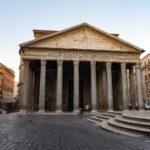For the intrepid tourist who wishes to travel this land, he must first know a little of this famous history, in order to feel safe and not to miss an important part of this impressive area, in Rome.
At the beginning of Rome as its creation, doubts arise and from them mythical stories, which are never refuted, and remain in the popular imagination of this beautiful city, according to these legends mark the beginning of this beautiful story of 753 BC, when Romulus (a son of the God Mars and a descendant of the Trojan prince Aeneas), killed his twin oar and became the first king of the city.
These legends have never been proven, but Rome believed them to be true and was proud of them, leaving for example a very important symbol that was turned into a statue, namely a she-wolf, which, according to legend, is the animal that saved and suckled these two creatures, which then grew up and generated this story that is the history of Rome.
Later, on the throne, commanded by Romulus, he decided to organize the famous rape of the Sabine women. The second king of Rome, Numa Pompilius (715-673 B.C.), was a Sabine considered just and devoted to religion. One of the religious traditions he instituted was the selection of virgins to be priestesses of the goddess Vesta.
Continuing this exciting story, we stop at the time of the reign of the third, more precisely in Tulio Ostilio, (672-641 BC), the Romans began to explore new territories, and one of them, whose conquest was their goal was the city of Alba Longa. The Romans destroyed it, thinking that it was a punishment for the negligence of the Gods, and appointed Anco Marzio as its fourth king.
Marzio, who ruled from 640 to 617 BC, founded the port of Ostia at the mouth of the Tevere. The last three kings of Rome were three rich Etruscans. Lucius Tarquinius Priscus (616-579 BC) who had reclaimed the marshes between the hills and paved an area destined to become the site of the market (the future Roman Forum). Servo Tullius (578-535 BC) organized the Roman army into groups of one hundred men called centurions and seems to have built new walls around the city. The seventh king, Lucius Tarquinius the Superb, was expelled in 510 BC after his son cruelly raped Lucretia, a virtuous Roman matron and wife of Collazius. The deposition of the last Etruscan king put an end not only to monarchy as a form of government, but also to the great and profound influence that the Etruscans had since exerted on all aspects of early Roman life.
During the Roman Republic, Rome became a major regional power in Italy. The city conquered many surrounding territories and established a series of colonies to expand its influence. The Roman Republic also experienced internal conflicts, particularly between the patricians (the aristocratic elite) and the plebeians (the lower class), which eventually led to the expansion of the plebeians’ political and social rights.
In the 1st century BC, the Roman Republic experienced a series of civil wars, including the civil wars between Julius Caesar, Pompey and Crassus. Caesar eventually became dictator of Rome, but was assassinated in 44 BC. The Roman Republic was then replaced by the Roman Empire, under the leadership of Emperor Augustus.
Under the Roman Empire, Rome became the largest city in the ancient world, with a population of over a million. The emperors built many public buildings, temples, amphitheaters and aqueducts to meet the needs of the growing city. The Roman Empire also extended its influence throughout the Mediterranean basin, conquering vast territories in Europe, North Africa and the Middle East.
Over the centuries, the Roman Empire had its ups and downs, with periods of prosperity and peace, followed by periods of decline and war. In the 4th century A.D., the Roman Empire was split in two, with the Western Roman Empire and the Eastern Roman Empire. The Western Roman Empire eventually succumbed to barbarian invasions and fell in 476 AD, while the Eastern Roman Empire survived for nearly a thousand years as the Byzantine Empire.
After the collapse of the Western Roman Empire in 476 AD, Rome fell to the Ostrogoths, a Germanic people, in 493. During this period, Rome became the capital of the Ostrogothic Kingdom of Italy, which lasted until 553, when the Byzantine Emperor Justinian conquered Rome and added it to his Empire.
Rome became an important city in the Byzantine Empire, and several buildings, such as St. Peter’s Basilica, were built under the direction of the Byzantine emperors. In the 8th century, the Lombards, another Germanic people, conquered Rome and created their own kingdom. However, in 800, Charlemagne conquered Rome and was crowned emperor of the Holy Roman Empire by Pope Leo III.
During the Middle Ages, Rome remained under the control of various powers, including the Normans, the Counts of Tusculum, and the Papacy itself, which became a major political power in Italy. In 1309, Pope Clement V moved the papal seat to Avignon, France, but in 1377, Pope Gregory XI returned to Rome, re-establishing papal power in the city.
In the following centuries, Rome became the center of the Italian Renaissance, with great artistic and intellectual activity in the city. The popes built many buildings and monuments, such as the Sistine Chapel and the Trevi Fountain. However, the city also experienced periods of conflict and destruction, especially during the Italian wars and the looting by the French and Spanish armies.
In 1870, Rome finally became the capital of the new Kingdom of Italy, ending nearly a thousand years of papal rule over the city. Since then, Rome has become an important city within the Italian Republic, hosting many important political and cultural institutions. The city has also become a major tourist destination, attracting millions of visitors each year to discover its rich historical and cultural heritage.





